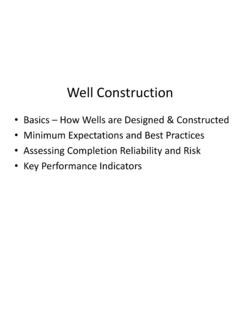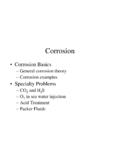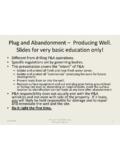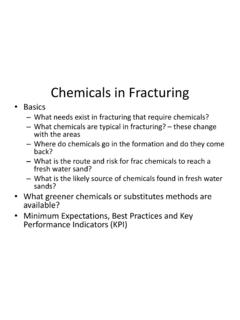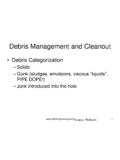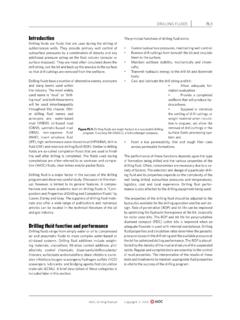Transcription of Brines and Other Workover Fluids - …
1 Brines and Other Workover Fluids Purposes Selection Filtration needs Placement fluid Loss Control Cleanup and Displacement of Muds Limitations Alternatives3/14/20091 George E. King Engineering of displacement prior to cementing, removal, formation pressures during completion and intervention operations, repair operations as a circulating or kill fluid medium, packer Fluids ,3/14/20092 George E. King Engineering of Brines (cont.)6. In some stimulations as base Fluids ;7. Enable cleanup of the zone prior to running screens;8. Reduce friction while running screens & equipment;9. Avoid damaging the well after completion, stimulation, or repair;10. Allow Other well operations to be E. King Engineering Circulating a Well Really Clean It Out? Not necessarily. Clean-out efficiency depends on: Ability to remove the solids from returning Fluids , fluid hydraulics - the flow rates in every section, Ability to disperse, then lift solids out of the well, Ability to effectively remove the dope, mud cake, residues, etc.
2 , from the pipe E. King Engineering from a cleanout scraper run dope, wirelinegrease, rust, mud, etc., are common E. King Engineering of the brine Must control at every phase of the be able to filter the brine to 5 to 10 microns with beta of with the formation, well equipment and all operations and and scale dropout must be requirements from the and disposal requirements at the and availability to fit the E. King Engineering TypeBrine FormulaDensity Range (ppg)Chloride - - - - - - - - SaltKHCO2 - SaltNaHCO2 - - - - - - - Types and Respective Density Ranges World Oil, Modern Sand Face Completion, 20033/14/20097 George E. King Engineering Density FluidsNitrogen to lb/galwater to lb/galkerosene and to lb/galMost low density Fluids are not be usable because of migration, flash point, or stability issues. 3/14/20098 George E. King Engineering and Pill Design The displacement must be designed to obtain effective mud removal (dispersementand lift) & water wetting of casing.
3 Keys: disperse and thin the drilling fluid compatibility with the following Fluids ( brine , acid, cement, etc. lift out debris and junk water wet pipe remove pipe dopeeffectively displace the mudSource: Wellcert3/14/20099 George E. King Engineering for thinning base fluid effective brine transition system must further thin and strip the mud and create wellbore carrier spacer must sweep out the solids and clean any coating from the pipe or rock that could cause damage separation spacer must do the final cleaning and separate the residual mud from the brine . brine must sweep the spacer out. At this point the well should be E. King Engineering and Transition SpacersSpacer TypeFunctionMinimum Annulus CoverageWBMOBMBase FluidThin & mud condition start dispersement250 to 500 ftWater, and some brinesBase oil (composition varies)TransitionMud to spacer, cuttings removal500 to 1000 Viscous pillViscous PillWas hClean pipe500 to 1500 Water+ WBM surfactantOil + OBM surfactantSeparationSeparate wash from completion brine500 to 1000 Viscous pillSurfactant gel?)
4 Some water gels if FluidCompletion fluidFillCompletion FluidCompletion Fluid3/14/200911 George E. King Engineering Flush Contact TimesPump Rate, bpmAnnular Velocity, ft/minBarrels PumpedColumn Length, ftContact Time, minutes on one 5/8 casing in 12-1/4 hole, annular area = ft23/14/200912 George E. King Engineering profile in a well with decentralized pipe. Note That most of the flow comes along the top of the pipe. This affects cleanup and residence time of the fluid on the wellbore. The lower section of the wellbore may remain buried in cuttings and never have contact with any of the circulated flow area3/14/200913 George E. King Engineering of the annulus to displace Fluids and mud cake depends partly on annulus changes as casing replaces the drill string. As the annular space decreases velocity for any rate increases in the smaller area and the back pressure on the bottom hole may also down the casing and up the small annulus can produce very high friction pressure and raised B H E.
5 King Engineering Considerations Well control is key consideration in selection of the pill sequence. In many cases, it is only possible to get thin, light Fluids into turbulence Pumping Fluids to displace oil based Fluids without suitable surfactant/solvent packages to disperse the mud can result in sludgesthat are insoluble except in aggressive solvents For deepwater wells, low temperatures can impact surfactant effectiveness3/14/200915 George E. King Engineering Capacity Pills in turbulence lose carrying capacity if the annular velocity drops below that required for turbulence ( entering larger diameter pipe such as a riser) In high mud weight, the risk of inducing barite sag needs to be considered if mud is thinned (displacement pills thin the mud to the point it can no longer support barite)3/14/200916 George E. King Engineering As depth and hole angle increase, the minimum pill volume (based on largest annular hole length) should increaseto allow for contamination, : If MD < twice TVD, annular fill length > 80 m (260 ft), If MD > twice TVD, annular fill length > 125 m (410 ft), Contact time (the time that critical points in the well are exposed to the pill) depends on reaction of surfactant/solvent to mud.
6 For surfactant pills, plan for contact times of greater than 4 minutes for best results. 3/14/200917 George E. King Engineering PRACTICES AND DESIGN CRITERIA Good mud thinning fluid is continuous phase of the mud: for water based mud pumping 50 bbl (8m3) of water as the first displacement pill will effectively thin mud, 50 bbl (8m3) of the mud base fluid can be pumped in the case of oil based muds. (check oil compatibility) Before any displacement, the compatibly of the spacers with the mud and the ability to water wet steel surfaces should be checked at ambient and bottom hole temp to confirm compatibility. In deep water, tests at lower temperature will be needed3/14/200918 George E. King Engineering PRACTICES AND DESIGN CRITERIA All tests should be done on field mud samples to ensure mud is effectively sheared and has representative particles/cuttings Water wetting surfactants are generally effective >3% vol/vol concentration, little additional benefit is obtained above 10%.
7 Solvents and mechanical or hydraulic agitation are required to remove sludges and pipe dope3/14/200919 George E. King Engineering Displacement of mud from an annulus is complex. The main driving forces: time of contact flow rateand frictional forces density mechanical agitation pipe centralization3/14/200920 George E. King Engineering AND ISSUES fluid Interface area increases w/ hole angle In deviated wells the eccentricity of the displacement string may reduce displacement. Pipe rotation and/or reciprocation is needed. At low temperature (<40oC/104oF), OBM is very viscous ( synthetic based mudsare worst), circulating to warm the annular contents reduces the E. King Engineering AND ISSUES High circulation rates may be better (even in laminar flow), they reduce the boundary layer thickness on the casing wall. (Watch wash-out potential of soft sands) Turbulence is best, flow rate must be calculated allowing for pipe eccentricity.
8 A complete wellbore hydraulics check is necessary. High rates (300 ft/min?) may reduce the fluff (80% of the outer layer of the filter cake that does not contribute to fluid loss control); sharply reducing the amount of solids in the well without reducing fluid loss control. 3/14/200922 George E. King Engineering PRACTICES AND DESIGN CRITERIA High flow rates will always be better even if turbulence cannot be achieved Pipe movement will improve displacement efficiency. Multi-function circulating subs should be used, currently the best tools open by setting weight down, incorporating a clutch mechanism to allow rotation. Do not stop displacement once pills enter the annulus Circulate to warm mud and fine up shakers (increase screen mesh number) to reduce particles in the fluid when possible, condition mud (reduce rheology). Use reverse circulation if possible when displacing with lighter E. King Engineering , Cakes, Breakers and Particles Drilling mud is the best known particulate based fluid loss control system.
9 Particles are sized to bridge on the face of the formation. Carbonate and salt are most common. Breakers are acid, oxidizers and enzymes. Filter cakes very effective in preventing losses as long as over-balance pressure is maintained. Cakes are very sensitive to swabbing, but are never completely Tool systems sensitive to plugging by E. King Engineering Damage? Dirty particles, unsized particles, debris and pipe dope are severe formation damage problems. Protecting the perforations with the right particles during a Workover improves chances of well improvement afterwards. The type of carrier fluid and the gels are v. important Clear (no particles) Brines are not always best solution3/14/200925 George E. King Engineering Pill Displacement A spacer or displacement pill for displacing a polymer system carring sized particulates should be to ppg heavier and about three times the low shear rate viscosity (at sec-1) of the fluid being displaced.
10 3/14/200926 George E. King Engineering Change, Perfs Not Protected-100-80-60-40-20020401357911131 5% Change in PIShort Term PI ChangeLong Term PI of WellsSPE 26042 Data from a set of Alaska wells where the perforations were not protected during a Workover . No protection shows significant long term E. King Engineering Change After Workover - Perfs Protected-40-30-20-100102030405012345678 91011% Change in PISho rt Term PI ChangeLong Term PI of wellsSPE 26042 When perfs were protected, that was little risk of long term E. King Engineering Pills: Summary of Overall Effectiveness in Non Fractured Wells-25-20-15-10-505101234567% Change in PISized Borate Salts (4)Cellulose Fibers (3)Sized Sodium Chloride (12)No Near Perf Milling (6)Near Perf Milling or Scraping (3)No Near Perf Milling (8)SPE 26042 Near Perf Milling or Scraping (10)HEC PillsNo PillsSized particulates, particularly those that can be removed, are much less damaging than most E.
